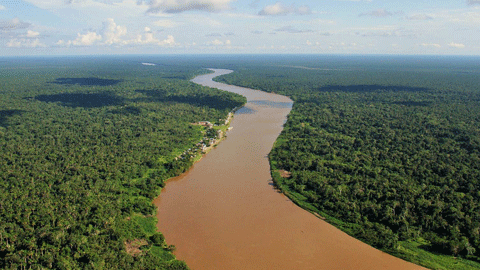Largest Peatland of the Amazon Discovered to Contain Over 3 Billion Tons of Carbon When Mapped for the First Time
The area of the largest peatland in the Amazon and its carbon store has been mapped for the first time. The researchers estimated that over three billion tons of carbon is stored within the geological basin which is almost the size of England. According to the research group, by preserving the peatland, large carbon emissions to the atmosphere could be avoided.

The Amazonian forests are known to harbour large stores of carbon locked up in their trees.
- According to the new research, the highest levels of carbon per square metre are in the Amazonian peatlands. However, the results show surprisingly that the highest concentration of carbon is stored not in the wood, but below the ground as peat, says Researcher Outi Lähteenoja from the University of Turku.
The researchers mapped and quantified the carbon stored in the largest area of peatland forest in Amazonia within a geological basin almost the size of England (120,000 km2). The researchers estimated that over three billion tons of carbon is stored within this ecosystem, with 90% stored below the ground as peat.
If this amount of carbon were to be released in the atmosphere, it would correspond to 40% of the carbon emissions caused by burning fossil fuels worldwide which is about 8.5 billion tons of carbon per a year according to the calculations of the International Energy Agency (IEA).
Protection Would Guarantee the Preservation of the Carbon Store
Dr Tim Baker, co-researcher and Associate Professor at the University of Leeds, presented the results to policymakers at ’Voices for Climate’ which was held on the margins of the recent UN Climate Change Conference COP20 in Lima, Peru.
- Mapping and quantifying the amount of carbon stored in these ecosystems is an important part of prioritising national strategies to mitigate climate change. For example, these peatlands occupy just 3% of the forested area of Peru, but contain almost 50% of the total amount of carbon stored above the ground in all Peruvian forests, said Barker.
Ordinarily in tropical forests, the vast majority of carbon is emitted back to the atmosphere as carbon dioxide, as trees die and decompose. However, waterlogging in peatlands means that decomposition is very slow and the carbon accumulates as peat.
- The peatlands we studied are largely intact, in contrast to tropical peatlands in Southeast Asia that have been exposed to decades of destruction, leading to huge carbon emissions and biodiversity losses, added Katherine Roucoux, who is a lecturer at the University of St Andrews and part of the research group.
However, most of the peatland area, including the most carbon-dense peatland type, currently lies outside of the protected areas and threats are increasing.
- If these carbon-rich forests could be protected too, then large emissions of carbon to the atmosphere could be prevented, says Roucoux.
The Grand Project of an International Research Group
The study was undertaken by researchers from the Universities of Leeds, St Andrews, Edinburgh and Turku, in collaboration with the Research Institute of the Peruvian Amazon (IIAP).
- Peatland forests are different from other Amazonian forests as they are typically dominated by small-statured trees or palms. We can see these differences not only on the ground but also from space using satellite imagery. These differences allowed us to map the extent of the peatlands and distinguish the different types of peatland forest. Crucially, this approach allowed us to distinguish a type of forest dominated by small trees, or ‘pole’ forest – the most carbon-dense peatland type, explains Freddie Draper, a PhD student at the University of Leeds.
Draper is writing his dissertation on the topic and was the main author of the research article.
- By combining this satellite data with extensive field data we have been able to provide spatially explicit estimates of the amount of carbon stored in these ecosystems for the first time, says Draper.
Funding for the project came primarily from the UK Natural Environment Research Council (NERC). The article was published in the scientific journal Environmental Research Letters in December.
Text: Erja Hyytiäinen
Photo: Oscar Jarama/IIAP